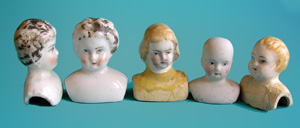Becoming a visitor in the 1980s to Miniatura, the world’s best dolls’ house show held twice annually in Birmingham, was a mixed blessing. Now that I exhibit at the show and am probably the longest serving journalist reporting the show, it still is. The problem is one of starving in the midst of abundance. Miniatura, which attracts the best artisans in miniature in every discipline, was already over a hundred exhibitors strong when I began visiting five years from the start. Now it has regularly around 250 exhibits, in miniature, each table of miniature things, if expanded magically to full size, would be a shop stuffed full of fabulous things. The lovely problem of how to ‘do’ every single one of 250 shops in a day is surmounted by ambitious visitors who buy the weekend ticket and then study the brochure and make notes on Saturday night instead of gibbering through the little paper bags like Gollum on a gloat-fest, which is what the rest of us are doing.
New to the delights of spending an entire day shopping for my dolls’ house, whilst I ran rapturously from table to table and did manage to see most things, I was struck at once by the absence of a particular item. There were plenty of dolls to choose from but where were the dolls with glass eyes? I could see that every other department of household necessity was catered for from Tudor chests to broken eggs and moreover, in every price bracket from child pocket money to private museum buyer with matching chequebook. Most things too seemed to be available in every form: from wood and miniature saw, through kit of precut parts, via made for you to paint, to finished, polished, inlaid and playing music. The doll kits, however, twenty years ago, were really basic and the finished porcelain dolls all looked like clones to me, albeit nicely dressed. I wanted more, I wanted real miniatures of the beautiful Victorian dolls I had seen on the Antiques Road Show and in the doll museum. I wanted dolls’ house dolls with all the attributes of big dolls. I wanted real hair you could comb, pierced ears for earrings, separate fingers in proper hands to hold things, moveablilty so the dolls could sit or stand convincingly, bare feet with toes, toe nails and finger nails and, most of all, glass eyes, so that when you looked at the doll, it looked back!
With a bit of research it became apparent that there were good reasons for the proliferation of dim-looking doll clones. Few sources of the plaster of Paris moulds to make the doll parts existed. These had been made by American pioneers in the use of small domestic kilns for doll making. They had taken the moulds from antique dolls. Victorian dolls house dolls had always been the poor relations of the doll world, churned out in sweat-shop factories mainly staffed by child outworkers who were able to deal with simply shaped parts with fewer costly breakages. Equally basic were the clones taken from existing old dolls. There were just a couple of artists making moulds from new sculpts. That was why all the dolls looked the same. What I didn’t appreciate, until I started, was how difficult it was to make a miniature porcelain doll. I had no idea of the complexity of the multi-stage process, of the danger to health of some stages, of the high wastage rate of poured parts, of the difficulty of controlling a kiln to produce reliable results. I didn’t know how temperamental porcelain can be, how inferior the results of using certain brands of plaster to make moulds, the impossibility of finding a mould release agent that works in miniature detail. I had no idea of the sheer, screaming frustration of modelling a figure that looks even remotely like a human being.
Now there are wonderful artisans making dolls’ house dolls from every substance you can imagine. Kits, information and help for those who aspire to make their own are abundant. Back in the early eighties I was plunging head first into an echoing vat of doinking nothingness.
Ignorance is not only bliss, it fuels the supreme self confidence bourne of stupidity that allows one to sink all one’s paltry savings into attending a one-day ‘how to make a big porcelain doll’ course, certain, from a position of amoeba genius, that one will be able to miniaturise all the information, with ease, at home. Thus it was that a proto-miniaturist, after just one visit to the world’s best show, set out utterly determined to make glass-eyed dolls, with everything.
Be warned: Miniatura will stretch your brain, like raw pastry on a hot summer day and the weekend ticket is a good investment.

